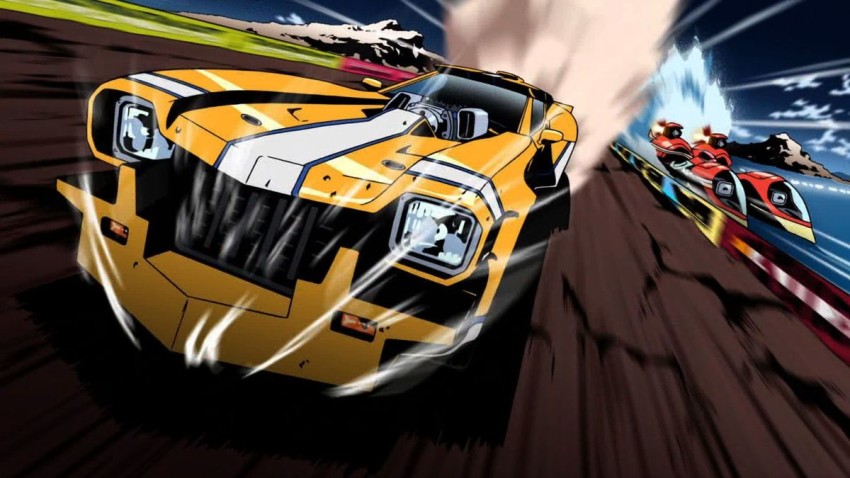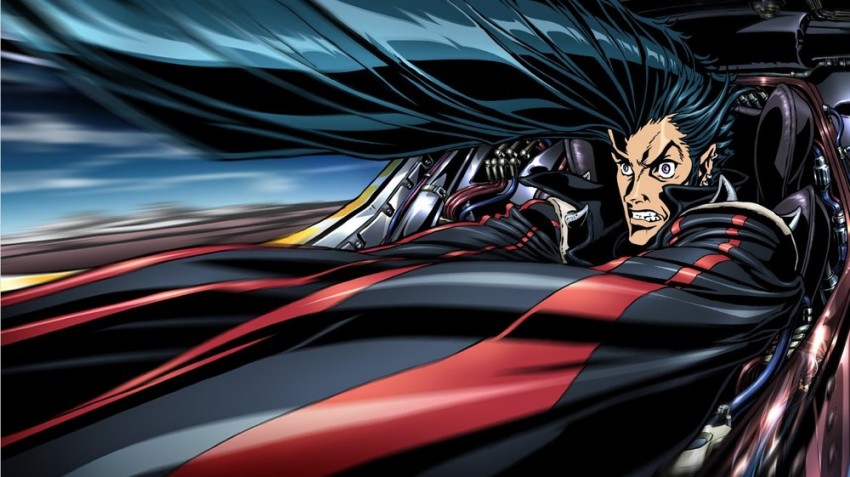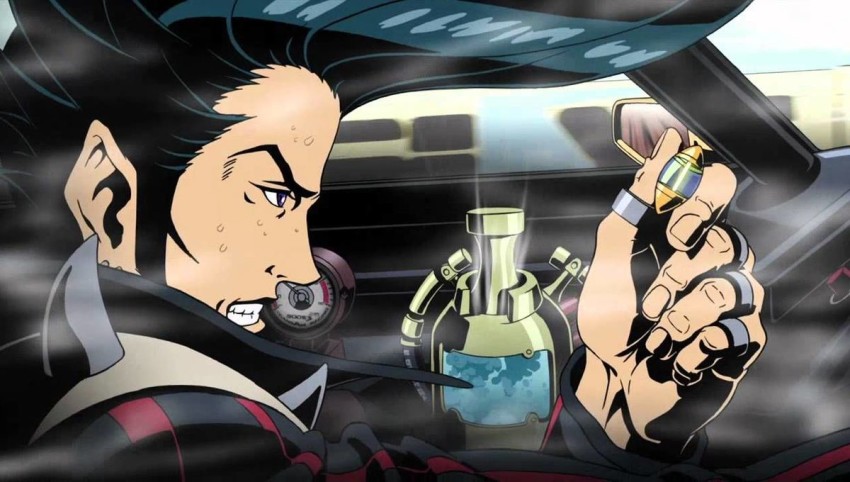Redline
September 18, 2019 · 0 comments
By Jonathan Clements.
 It’s all over for the good-hearted racer boy JP when his souped-up Trans Am crashes at the finish of the illegal Yellowline contest on planet Dorothy. Meanwhile his double-crossing colleague Frisbee is merrily counting the cash from an evil interstellar syndicate that has rigged the race.
It’s all over for the good-hearted racer boy JP when his souped-up Trans Am crashes at the finish of the illegal Yellowline contest on planet Dorothy. Meanwhile his double-crossing colleague Frisbee is merrily counting the cash from an evil interstellar syndicate that has rigged the race.
The next race – the highly illegal, immensely prestigious Redline – is held only once every five years, and this time is scheduled to cross the face of Roboworld: a deeply private, heavily armed fascist dictatorship. Roboworld’s Supreme Leader is determined to teach the racers a lesson by killing them all, preferably, before the cameras of the galaxy’s media outlets descend on Roboworld and take pictures of all his super-weapons, cyborg armies and doomsday devices. The sheer risk is too much for several fellow racers, whose withdrawal from the competition puts JP back onto the starting grid, so long as he is prepared to cheat death in a race against killer opponents and enemy soldiers.
Takeshi Koike’s Redline plays as if it is the finale of a massive series that unites multiple unrelated genres in the anime world: one participant is a fairy princess; another seems to have escaped from a beat-em-up arcade game; still another is a machine-man who is literally plugged into his vehicle. But our hero’s nickname is “Sweet JP”, a sneering epithet hurled at him by the others because he’s too fair-minded to use landmines, rocket-propelled grenades or tactical nukes just to win a race. Nice guys finish last, which is why the odds on JP are a mouth-watering 25,000 to one. The result is sheer mayhem, as if the cast of Top Gear raced through minefields on the North Korean border, or the cast of the Cannonball Run took on Darth Vader.
Redline is in love with the physicality of cars. Even those racers who are not literally plugged in to their seats are twisted, bent and broken by g-forces. The film’s imagery is a 180-degree spin-out from the naturalism of Isao Takahata or Satoshi Kon’s careful recreation of the real. Koike’s filming frequently “crosses the line”, switches directions, or bends the perspective of his characters as if they and their vehicles are symbiotic life forms. His anime feature is tricked out with vibrant primary colours and larger-than-life caricatures, entirely beholden to a single aim: winning.
Five years in the making, and drawing on a shadowy undertow of obscure short films and festival experiments, Redline is unapologetically brash, unforgettably loud, and mercifully short, clocking in at a mere 97 minutes. But it is also the latest entry in a long tradition of sporting anime that began in the 1960s with tales of baseball, volleyball and martial arts, before diversifying in the 1970s into ever-crazier car-racing stories.
 Some have suggested that Redline’s prime inspiration must be the mismatched cartoon competitors of Wacky Races (1968), but the old Hanna-Barbera show does not have quite the footprint or following in Japan that one might expect. Wacky Races was broadcast in Japan in 1970 as Chichiki Machine Mo Race (Furious Crazy Machine Race), but we ought to remember that Katsuhito Ishii was only four years old at the time. He was, however, a much more impressionable ten years old in 1976, when TV Asahi broadcast the 21 madcap episodes of Machine Hayabusa, an animated series that took the clichés of sports shows and combined them with an exuberant sci-fi plotline.
Some have suggested that Redline’s prime inspiration must be the mismatched cartoon competitors of Wacky Races (1968), but the old Hanna-Barbera show does not have quite the footprint or following in Japan that one might expect. Wacky Races was broadcast in Japan in 1970 as Chichiki Machine Mo Race (Furious Crazy Machine Race), but we ought to remember that Katsuhito Ishii was only four years old at the time. He was, however, a much more impressionable ten years old in 1976, when TV Asahi broadcast the 21 madcap episodes of Machine Hayabusa, an animated series that took the clichés of sports shows and combined them with an exuberant sci-fi plotline.
At dinner before the film’s world premiere in Locarno, Ishii told me that Redline’s true inspiration was his childhood love of Machine Hayabusa, and his wish to make something that had the same sort of energy. In Machine Hayabusa, the world of formula one racing has been changed forever by the activities of a bunch of soulless swindlers, the Black Devil Team, led by the nefarious “demon lord” Ahab Mobildick. In a world where everyone is a cheat and cars are fitted with boosters, rockets and wings, only Ken Hayabusa, noble racer with the Saionji racing team, is prepared to play by the rules, in a series of raging races, animated with a loving interest in the technology of tomorrow lurking beneath the cars’ various sci-fi engines.
Machine Hayabusa was itself part of a tradition. Above all, it bears a strong resemblance to the iconic Speed Racer (1967), and indeed to Rubenkaiser (1977), a remake in all but name, which filled Machine Hayabusa’s slot on TV Asahi the following year. But that is only to be expected when children’s cartoons work on a limited product cycle. Every two years, cynical producers can wheel out the same old shows with a respray, and hope that nobody notices. But for a pre-teen boy with a love of racing, there is always the movies, and the youthful Ishii seems to have been obliged by the appearance of Cannonball Run (1981). Released in Japanese translation with the stark, one-word title, Cannonball, it featured a racer called JJ (Burt Reynolds) taking on a motley series of archetypal comedy creations…
 Redline inherits Cannonball Run’s sense of insider humour. Sometimes it is as if we are watching the all-out, chaotic finale of a long series, in which characters with long back-stories are finally getting their just desserts. In Cannonball Run, the famous celebrities were often playing to their public personas, or reprising famous characters from other movies. In Redline, the casting of certain voice actors often evokes connections within Japanese media that are invisible to most English-speaking viewers. Above all, many are alumni from earlier Ishii productions: be they movies, pop videos or commercials.
Redline inherits Cannonball Run’s sense of insider humour. Sometimes it is as if we are watching the all-out, chaotic finale of a long series, in which characters with long back-stories are finally getting their just desserts. In Cannonball Run, the famous celebrities were often playing to their public personas, or reprising famous characters from other movies. In Redline, the casting of certain voice actors often evokes connections within Japanese media that are invisible to most English-speaking viewers. Above all, many are alumni from earlier Ishii productions: be they movies, pop videos or commercials.
JP’s double-dealing mechanic Frisbee is voiced by Tadanobu Asano, the edgy star of movies like Takashi Miike’s Ichi the Killer and Ishii’s earlier Sharkskin Man and Peach-Hips Girl. Another Sharkskin alumnus is the comedian Tatsuya Gashuin, who plays the racer Lynchman. Meanwhile, the actress-model Akemi Kobayashi, previously seen in Ishii’s Party7, provides the voice in Redline of the ditzy, pneumatic racer girl Bosbos. Rival racer Sonoshee Mclaren is one of the few characters who is not played by someone with apparent former connections to Ishii; she is voiced by actress/model Yu Aoi, who has previously appeared in films including Mushishi and All About Lily Chou-Chouand was last heard at Scotland Loves Anime in The Case of Hana & Alice. JP himself is voiced by Takuya Kimura, a true Japanese superstar who has dominated the airwaves for 15 years as one of the members of the all-singing, all-dancing boy-band SMAP. Garlanded with awards for serious acting on TV, he was also the star of the Space Cruiser Yamato live-action movie.
Redline is also something of a reunion for a number of characters from previous productions that bear the hallmarks of Koike and Ishii. The racers Trava and Shinkai, little more than also-rans in the film, were once the stars of their own four-part video series from the Madhouse studio, Trava: Fist Planet (2001-2), directed by Katsuhito Ishii and Takeshi Koike. Blink during the Yellowline race stage that opens the film, and you might miss the dog-faced driver Bons, who previously appeared in Ishii’s computer-animated short pieces Hal & Bons. The odd little-and-large pair of drivers from Earth, Todoroki and Miki, first had their appearance in yet another Ishii short, as the inept stand-up duo The Mole Brothers. It’s as if Redline is a Cannonball Run for the Ishiiverse, dragging together half a dozen strands from festival shorts, showreels and anthology discs from the previous decade. And then shooting at them with a big orbital laser…
Jonathan Clements is the author of Anime: A History. Redline is screening at this year’s Scotland Loves Anime… again.
anime, Japan, Jonathan Clements, Katsuhito Ishii, Redline, Scotland Loves Anime, Takeshi Koike
Leave a Reply